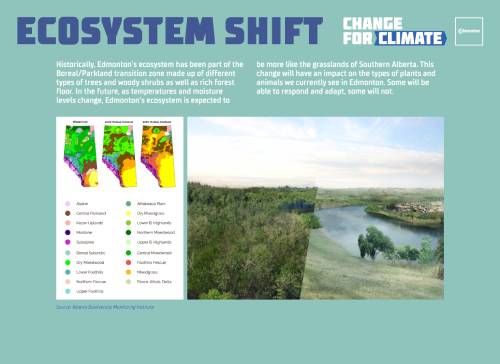The closely linked topics of climate change and energy are issues of interest to many Edmontonians. A recent survey (2024) shows that 73% of Edmontonians are concerned about climate change and 74% agree that we need to take action now.
The City of Edmonton is actively addressing climate change in its operations and is working with Edmontonians and Edmonton businesses to become climate resilient. To support these efforts, the City has developed strategies and resources that examine climate issues, energy use, sources of energy, and ways to improve energy efficiency.
The City is committed to reducing greenhouse gas emissions to slow climate change while also exploring ways we can adapt to the changes we’re already experiencing due to a changing climate. This Energy and Climate Change FAQ introduces key terms related to energy and climate change and explains their connection. It aims to help readers understand relevant materials produced by the City, including the Energy Transition Strategy and Climate Resilient Edmonton: Adaptation Strategy and Action Plan.
Resilience
As you read through these questions and answers, think about the city as a system and how you would rate its resilience and how your choices affect resilience at an individual, neighbourhood and city-wide level.
In a city context, climate resilience refers to the capacity of a system to survive and thrive under changing conditions, and to maintain its functions during change. Through thoughtful planning and implementation of mitigation and adaptation actions, the city is on its way to becoming resilient.
Risks related to climate change and energy include our dependency on fossil fuels, our reliance on a centralized electrical system, and challenges posed by severe weather events such as heavy rain or heat waves.
Climate resilience planning begins with understanding climate projections for an area (in our case, Edmonton); assessing energy sources and usage; and the capacity of various systems, such as infrastructure and public services to maintain their ability to provide services under ever-changing conditions. By strengthening these systems, the city is better positioned to endure and recover quickly from climate-related impacts.
Climate resilience requires efforts in both mitigation (reducing emissions) and adaptation. When both are advanced, Edmonton will become closer to being a more resilient city.
Climate
Climate change refers to long-term shifts in weather patterns, including changes in temperature, precipitation, and the frequency or intensity of extreme weather events such as hurricanes, droughts, or floods. These changes occur over periods ranging from decades to millions of years.
While often used interchangeably, "climate change" and "global warming" are distinct: global warming describes the increase in the Earth’s average surface temperature, whereas climate change encompasses broader shifts in weather patterns.
Climate change can profoundly impact habitats by shifting average temperatures and precipitation, potentially making it difficult for plants, animals, and humans to survive.
Climate change is driven by a rise in global temperatures, caused by an increase in greenhouse gas (GHG) emissions. These gases accumulate in the atmosphere and trap the sun's energy, resulting in a warming effect.
While a natural balance of GHGs is essential to maintain Earth's average habitable surface temperature of approximately +15°C, human activities—primarily the burning of fossil fuels like coal, oil, and natural gas—have significantly disrupted this balance.
When fossil fuels are burned for energy, they release large amounts of carbon dioxide (CO2), the most common greenhouse gas. CO2, along with other gases such as methane (CH4) and nitrous oxide (N2O), traps heat in the atmosphere, intensifying the greenhouse effect and causing the planet to warm.
This rise in global temperatures destabilizes weather systems, jet streams, and other climate patterns. The resulting effects include extreme weather events, such as heatwaves, heavy rainfall, and—for cities like Edmonton—both deep freezes and above-average heat days.
Because CO2 makes up the largest share of GHG emissions, these emissions are often referred to as "carbon emissions." However, other greenhouse gases, like CH4 and N2O, also play a significant role in climate change by further amplifying the warming effect.
Climate describes the average of weather patterns over large areas for extended periods of time, typically 30 years or more.
Weather refers to current or short-term atmospheric conditions, such as temperature, precipitation, humidity and wind, and is very local in nature.
Greenhouse gases (GHGs) trap heat in the atmosphere, contributing to the greenhouse effect. Carbon dioxide (CO2) is the main naturally-occurring GHG. The most common human-produced GHGs are CO2, methane (CH4) and nitrous oxide (N2O).
GHG emissions result from the burning of fossil fuels for residential and industrial purposes (producing mainly CO2), from agricultural and oilfield activities (mainly CH4), and from vehicle emissions (mainly CO2 and N2O).
Natural sources like volcanoes and forest fires also emit GHGs. Water vapour is another notable GHG. All GHGs released to the atmosphere contribute to the greenhouse effect, regardless of where in the world they are emitted.
The greenhouse effect is a naturally occurring process where GHGs in the atmosphere absorb and trap heat, keeping the planet warm at an average temperature of about +15°C. The natural greenhouse effect is essential for life on Earth; without it, the average surface temperature of the planet would be -18°C.
Human activities have intensified this effect by adding excess GHGs to the atmosphere, disrupting the natural carbon balance, increasing the greenhouse effect and accelerating the rate at which the Earth’s temperature rises. These increased temperatures can lead to more frequent and extreme weather events linked to climate change.
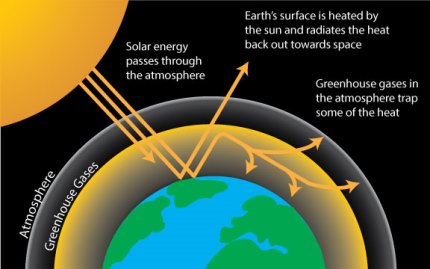
Being carbon-neutral means balancing the amount of carbon dioxide (CO2) released into the atmosphere with actions that offset these emissions. For example, a community might plant trees to absorb greenhouse gas emissions that are produced as it heats and powers local buildings.
Thus, although greenhouse gases are released, actions are being taken to reduce the net emissions, moving the community closer to being carbon-neutral. When talking about carbon neutrality, the terms carbon, carbon dioxide, and greenhouse gas emissions are often used interchangeably.
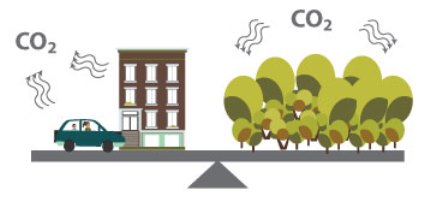
Carbon capture, utilization and storage (CCUS) is a technology designed to reduce carbon dioxide (CO2) emissions from industrial processes.
It works by capturing CO2 before it is released into the atmosphere and either uses it for other purposes—such as producing building materials like concrete and bricks or for enhanced oil recovery—or injects it into deep underground geologic formations like saline aquifers or depleted oil and gas reservoirs for long-term storage.
By preventing CO2 from being released into the atmosphere, CCUS contributes to efforts aimed at mitigating the greenhouse effect and addressing climate change.
Climate mitigation refers to efforts that slow climate change by reducing or preventing the release of greenhouse gases to the atmosphere. Examples include using renewable energy, improving energy efficiency, and transitioning away from fossil fuels. Edmonton’s mitigation plan is outlined in Edmonton’s Community Energy Transition Strategy and Action Plan.
Climate adaptation involves minimizing the negative impacts, reducing risks and embracing potential opportunities associated with climate change so that communities and ecosystems are prepared to cope with new or changing climate conditions.
Edmonton’s adaptation plan is detailed in Climate Resilient Edmonton: Adaptation Strategy and Action Plan.
Energy
Energy is the capacity to do work and can be used for various activities. It exists in forms such as thermal (heat), electrical, nuclear, chemical, and mechanical energy.
Non-renewable energy, sometimes called fossil fuels, comes from resources like coal, oil, and natural gas. These resources are described as being finite because we cannot make more of them. In Alberta, most of our energy comes from these sources.
Renewable energy comes from sources that can be naturally replenished, meaning that more will be available even as we use them. Renewable sources include solar, wind, hydro, geothermal energy, and biomass—organic material derived from plants and animals.
Biomass is made from things like crops such as corn and sugar cane, which are grown to make biofuels, or leftovers from the forest industry like wood chips, sawdust, and bark. This material can be turned into heat, electricity, or fuel, making biomass a useful and renewable way to create energy while also reusing waste.
Burning fossil fuels for energy releases stored carbon as carbon dioxide (CO2), a greenhouse gas that gets trapped in the atmosphere. Renewable energy sources, like solar or wind, generate minimal greenhouse gases, offering a cleaner alternative.
Co-generation is also called “combined heat and power” (CHP). When electricity is generated, particularly through the burning of fossil fuels, heat is also produced.
Rather than dispersing the heat energy through cooling towers or other means (and thereby wasting it), co-generation captures and uses it for heating water or for space heating. The captured heat can be used on-site or transmitted elsewhere.
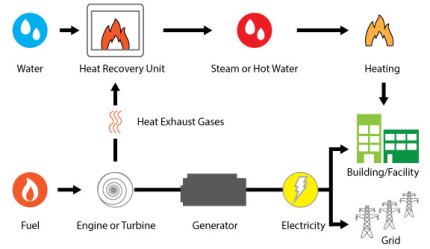
Centralized energy systems produce electricity far away from where it is used. Large power plants, like the natural gas-fired plants west of Edmonton, generate electricity and send it over long distances through transmission lines to homes, businesses, and other users.
These systems often use fuels like coal and natural gas or renewable sources like hydroelectric power, which is common in provinces like British Columbia, Manitoba, and Quebec, though less so in Alberta.
Centralized systems are reliable and can produce electricity on a large scale, but they have challenges. Sending electricity over long distances can lead to transmission losses, and users in remote areas may experience less reliable access due to these energy losses and make these areas more vulnerable to disruptions.
During power outages, many users connected to a centralized system can be affected at once because they rely on the same transmission network.
In contrast, decentralized energy systems produce electricity close to where it is used, often using renewable sources like solar or wind. These systems give local communities more control over their energy and can reduce transmission losses.
While they are more environmentally friendly, decentralized systems can face challenges like the need for new infrastructure to store and distribute energy effectively. During outages, impacts are often more localized, affecting only the specific area served by the system.
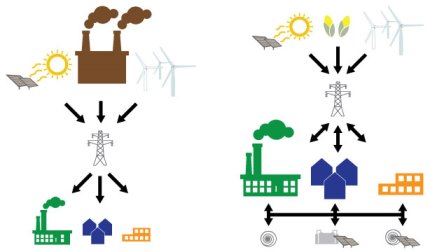
District energy is a shared energy network where a single energy provider supplies heating or cooling to multiple nearby buildings. For example, instead of each building having its own furnace or boiler, a large central system generates energy and distributes it through a network of pipes. This approach allows users to share installation and maintenance costs, leading to savings for everyone involved.
The University of Alberta’s main campus is a notable example of a district energy system with electricity co-generation, which is one of the largest systems of this kind in North America. Another example is Blatchford Renewable Energy, a utility operated by the City of Edmonton, which delivers heating, cooling, and hot water services to homes, businesses, and schools in the Blatchford community.
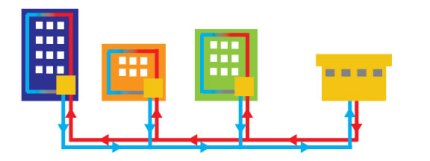
A heat pump is an energy-efficient device that transfers heat between the inside and outside of a building to provide heating and cooling. Instead of generating heat like a furnace, it works by extracting heat from the air, ground, or water and moving it to where it is needed.
In colder months, a heat pump pulls heat from outside and transfers it indoors; in warmer months, it reverses the process, acting like an air conditioner by removing heat from inside and releasing it outside.
Heat pumps use electricity to operate and are considered an environmentally friendly option because they can significantly reduce greenhouse gas emissions, especially when paired with renewable energy sources.
There are different types of heat pumps, including air-source, ground-source (geoexchange), and water-source systems, each suited for specific applications.
Hydrogen is a clean energy source that, when used in a fuel cell, produces only water, electricity, and heat. There are three different types of hydrogen:
- grey: uses fossil fuels and releases carbon dioxide
- blue: uses fossil fuels but captures and stores emitted carbon
- green: uses emission-free sources
While hydrogen would not be used at a household level, it can be an important piece in reducing our emissions at a larger level, such as industry, fleet, and in communities. Visit Edmonton Region Hydrogen Hub to learn how hydrogen fits into our city's future.
The City is exploring new sustainable transportation technology through its Hydrogen Bus Pilot by purchasing and testing new hydrogen-powered buses. This initiative involves testing two hydrogen buses in real-world conditions in Alberta.
Micro-generation is the small-scale production of electricity using renewable or alternative energy sources to meet the needs of a homeowner, business, or community. A common example is rooftop solar panels. The electricity generated can be stored on-site or, in many urban settings, fed into the existing electrical grid.
In Alberta, the Micro-Generation Regulation defines two categories of micro-generators:
- Small-scale micro-generators: Systems under 150 kilowatts, typically used by homes, farms, or small businesses.
- Large-scale micro-generators: Systems between 150 kilowatts and 5 megawatts, suitable for larger operations.
Energy mapping identifies how energy is used within a specific geographic area. This helps pinpoint energy demands and highlights opportunities to improve energy efficiency in that area, such as a neighbourhood. By understanding local energy use, energy mapping can guide initiatives to reduce consumption and greenhouse gas emissions.
Building green means designing and constructing buildings in ways that are environmentally responsible and resource-efficient throughout their entire life cycle.
This includes careful planning during design, using sustainable materials during construction, operating buildings efficiently to save energy and water, maintaining them with minimal environmental impact, and reusing or recycling materials during renovations or demolition.
Energy efficiency means less energy is used to perform the same service. For example, compact fluorescent lights (CFLs) or light emitting diode (LED) bulbs use less energy than incandescent bulbs to provide the same amount of light, thus making them more energy efficient.
Energy conservation means reducing energy use by taking actions such as turning off a light, turning down the furnace and wearing a sweater, or walking or cycling instead of driving.
Energy efficiency and energy conservation are both mitigation efforts that reduce greenhouse gas emissions.
Energy ratings provide a way to measure and compare how efficiently products use energy, helping consumers make informed choices. For example, Canada’s EnerGuide® labels appear on appliances, heating and cooling equipment, houses and vehicles, showing how much energy a product uses compared to similar models.
The international ENERGY STAR® symbol represents premium energy efficiency. Products with this symbol are tested to meet or exceed strict energy-saving standards while maintaining high performance. These ratings encourage the use of energy-efficient options, saving money and reducing environmental impact.
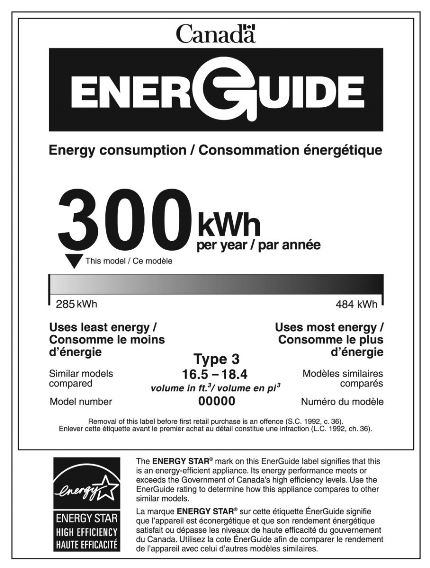
Energy use is measured in specific units depending on the type of energy. Household electricity is measured in kilowatt hours (kWh), which reflects the amount of power consumed over time. An electricity meter tracks and records this usage.
Natural gas, commonly used for home heating, is measured in gigajoules (GJ) using a separate meter. These units help determine the energy consumption and costs for your household.
To learn how to read your electricity meter, visit EPCOR’s website, where they provide detailed information on how electricity meters work and how to read them.
To learn how to read your natural gas meter, visit ATCO Gas’s website, which offers instructions on how natural gas meters work and how to read them.
Climate Change Adaptation
Climate adaptation involves lowering the risks and embracing potential opportunities associated with climate change so that communities and ecosystems are prepared to cope with new or changing climate conditions. When combined with climate mitigation efforts (actions that slow climate change by reducing or preventing the release of greenhouse gases to the atmosphere), we can become more climate resilient.
Sometimes called acute, short-term shocks, climate “hazards” are severe weather events that already occur, but may happen more frequently and with greater intensity as a result of climate change such as flooding, freezing rain, hail, high winds, or tornadoes.
Slow-onset climate stress refers to gradual impacts to the environment that occur only because of climate change. Examples include glacial retreat, where glaciers melt and shrink, and shifting ecosystems, which involve changes in habitats, species composition, and migration patterns.
Sometimes called “chronic stresses” these changes occur slowly but can have profound and lasting effects on the environment and communities.
See climate shock or hazard, above.
An ecosystem shift occurs when habitats, species types, migration patterns, and other ecological elements change due to a changing climate.
For example, as climate models predict a hotter and drier Edmonton by the 2050s, the region may become better suited for plants and trees that require less water and can tolerate higher temperatures, replacing some of the vegetation that thrives here today.
Assets and service areas are terms often used to describe how climate change might impact Edmonton or any other community.
Assets refer to the infrastructure and equipment that keep the city running smoothly. This includes roads, streetlights, power lines, water pipes, storage facilities, recreation centres, sports fields, and other tangible structures.
Service areas describe the functions and services provided by the city to meet residents' needs. Examples include access to clean drinking water, social services, recreational programming, and emergency management.
These two concepts are closely linked, as service areas depend on well-maintained assets. For instance, an effective emergency management plan relies on assets such as communication systems, accessible roads, fueling stations, and vehicles to ensure its success.
Learn More
Find more definitions and acronyms in the final pages of Edmonton’s mitigation and adaptation strategies:
Energy Transition Strategy: Building a Climate Resilient Edmonton
Climate Resilient Edmonton: Adaptation Strategy and Action Plan
And visit the Climate Data Glossary.
Contact Us
Environment and Climate Resilience
If you are calling from outside of Edmonton: 780-442-5311
Email changeforclimate@edmonton.ca
Phone 311


